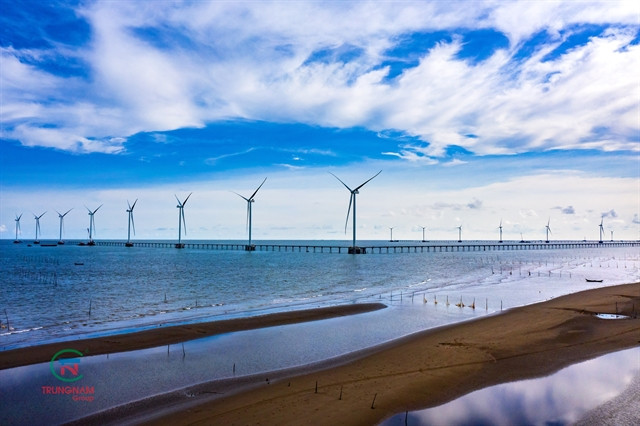 Trung Nam Tra Vinh 1 Wind Power JSC, a member of Trungnam Group inaugurates the Dong Hai I Wind Power Plant in Duyen Hai district, the Mekong Delta province of Tra Vinh in early 2022. (Photo courtesy of the firm)
Trung Nam Tra Vinh 1 Wind Power JSC, a member of Trungnam Group inaugurates the Dong Hai I Wind Power Plant in Duyen Hai district, the Mekong Delta province of Tra Vinh in early 2022. (Photo courtesy of the firm)Inthe workshop held by the Global Wind Power Association (GWEC) in collaborationwith the Institute of Energy from the Ministry of Industry and Trade (MoIT),the ministry announced that it has submitted the draft Power Master Plan VIIIto the Government for consideration and approval, adding the draft included a biddingpossibility for investors of the offshore wind power in Vietnam.
NguyenThi Thanh Binh, Deputy General Director of T&T Group, said: “Theroadmap for formulating and promulgating a pricing mechanism for offshore windpower projects has so far not been prepared, and there is a lackof specific and clear instructions.”
Binhadded even the term of offshore wind, onshore and offshore wind power were notvery clear in the current policies.
Sheconsidered the investment field was still very new to Vietnam and there weresome investors who only engage in “project development" with no realpurpose of investing in building the projects, thus the participation of thoseinvestors would likely distort the selection process of contractors and theactual requirements of the projects would likely not be ensured.
Inthis case, Binh said those investors selected for low bids may not be able tofulfill their commitments and result in failing the projects.
MarkHutchinson, head South East Asia of GWEC, said: “Businesses have to investbillions of US dollar for an offshore wind power project, even if it is a smallproject, so they needs policy clarity.”
Thehead said it needed at least eight years for an offshore wind farm to bedone and work from preparation level and getting loans for the projects was notan easy task.
Hesaid as domestic banks have limited loans, many investors have to askloans from foreign banks, which have to estimate risks and financial loss basedon the price mechanism.
Accordingto insiders, while Vietnam was studying and coming up with a bidding plan foroffshore wind power, they needed a transitional mechanism before bidding sothat they could learn from the experience of other countries to have reasonablesolutions.
Hutchinsontold the workshop: “No market in the world has mobilised the first 3,000MW ofoffshore wind power in through bidding,” adding it was necessary toimplement a fixed-price transition mechanism for the first 4,000MW and thenproceed to bid for the remaining 3,000MW for the period up to 2030.
Binhfrom T&T also said: “ It is the first stage of launching, shaping thedevelopment of a new and modern industry in Vietnam. Therefore, the Governmentmay consider starting with a mechanism to select investors on the basis of capacity,experience, finance to develop and support the industry. It will help shortenthe investor selection period, making projects to soon be deployed and put intooperation before 2030."
Citingexperiences from countries such as the Republic of Korea, Japan, Binh said,these countries also apply the preferential price mechanism (FIT) to promoteoffshore wind power development in the early stages.
StuartLivesey, CEO of the La Gan Wind Power Development Corporation, Country Directorof Copenhagen Offshore Partners (COP) in Vietnam also agreed there must be atransition period before switching to the bidding mechanism for offshore windfarm investment.
He added theoffshore wind power development needs to be regulated by an effective legalframework, to attract a wide range of developers, investors, contractors,suppliers and sponsors worldwide.
He said inTaiwan (China), prices for power purchase agreements from offshore wind powerprojects have shown a steady decline over the past six years from the initialFIT preferential price, through the transition period and currently acompetitive bidding reducing by about 60 percent from the initial tariff price.
In the role ofthe management agency, Doan Ngoc Duong, Deputy Director of the MoIT’s Instituteof Energy, said the ministry would consider the experience of the othercountries in order to promote the early stage development and createconfidence for investors.
Earlier, GWECsaid in its report that Vietnam with a whopping 475,000MW of offshorewind, Vietnam was poised to be South East Asia’s offshore wind leader over thenext decade, but clear regulatory frameworks and support schemes must be inplace to capture this potential.
The reportsaid if Vietnam wanted to secure these early phase projects, it was time to act now orthe first true offshore wind projects in Vietnam will not reach the commercialoperation date until2026 or later.
The reportsaid it was crucial that the Vietnamese Government put in place policiesnow that can support the long-term sustainable development of the sector.
Thus GWECwas calling on the Vietnamese Government to take a ‘transitional’ approachto offshore wind support schemes and to incorporate a systematic and openconsultation process with industry stakeholders to design future offshore windpolicy.
GWECrecommended establishing a new Feed-in-Tariff (FiT) for offshore wind thatcan support the initial stage of 4-5GW of true offshore wind projectsconnecting to the grid prior to, or parallel to, an auction mechanism beingimplemented in a ‘Transition Phase’.
GWECconsidered bidding as the help of other offshore wind markets scale-up andreduce costs quickly and could support Vietnam in doing the same. It willbe crucial to set-up an auction that can transition smoothly from a FiT scheme./.






























